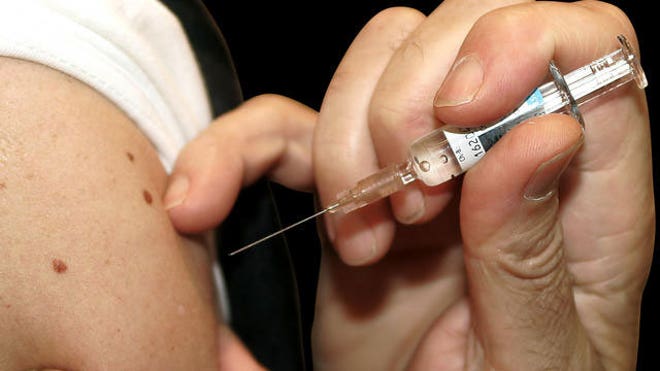
Getting a flu shot this season may not only greatly lower your risk of influenza this year, it may also lower your risk of heart disease, a new review from Canada suggests.
Results show that people who received the flu vaccine were 50 percent less likely to experience a heart attack or stroke, and 40 percent less likely to die from one, compared with people in the unvaccinated control group.
The flu vaccine could be an important way to maintain heart health and ward off strokes and heart attacks, the researchers said. They presented their findings at a cardiovascular disease research meeting Monday in Toronto.
In the study, Dr. Jacob Udell, a cardiologist at Women's College Hospital and the University of Toronto, and colleagues looked at four previous studies involving a total of more than 3,000 people whose average age was 60 — some with previous heart disease, and some without such conditions. Participants in all the studies were randomly assigned to receive a flu vaccine, no vaccine or a placebo injection, and were tracked for the following year.
The findings suggest that “perhaps that the flu vaccine is a heart vaccine,” Udell said.
During the year after vaccination, there were 187 cases of heart attacks or stokes, including 65 deaths.
Regardless of whether study participants had a history of heart disease, those who got the flu vaccine were less likely to have cardiovascular events, or die them from.
While the reason for the link is not exactly clear, Udell said it may be that when people develop heart disease, some factor "tips them over the edge," such as plaque clogging arteries, or lower levels of oxygen as a result of the flu.
The flu vaccine may stop this "tipping" by preventing flu, or by actually breaking up plaque in the arteries. “Either one is very provocative, and it's important to drill down and get the answer,” Udell said.
Dr. Sarah Samaan, a cardiologist and director of the Women’s Cardiovascular Institute at Baylor Heart Hospital in Plano, Texas, said the key to the link may be in reducing inflammation.
When someone gets the flu, blood levels of inflammatory substances rise, and inflammation of the blood vessels can trigger heart attacks.
“This happens because inflammation can make cholesterol plaques in the blood vessels unstable," Samaan explained. Unstable plaques are more likely to develop tiny cracks, which can cause blood clots to form. Such clots can block blood flow within arteries, causing a heart attack (if the blood vessel supplies the heart) or a stroke (if the artery feeds the brain), she said.
Udell cautioned that the 50 percent reduction in cardiovascular events seen in the study may be a high number, but said that even if the flu vaccine reduced the risk of a heart attack or stroke by just 10 percent, vaccination could make a major dent in saving lives.
A larger study could help firm up the numbers, he said, and he hopes to start one.
Results show that people who received the flu vaccine were 50 percent less likely to experience a heart attack or stroke, and 40 percent less likely to die from one, compared with people in the unvaccinated control group.
The flu vaccine could be an important way to maintain heart health and ward off strokes and heart attacks, the researchers said. They presented their findings at a cardiovascular disease research meeting Monday in Toronto.
In the study, Dr. Jacob Udell, a cardiologist at Women's College Hospital and the University of Toronto, and colleagues looked at four previous studies involving a total of more than 3,000 people whose average age was 60 — some with previous heart disease, and some without such conditions. Participants in all the studies were randomly assigned to receive a flu vaccine, no vaccine or a placebo injection, and were tracked for the following year.
The findings suggest that “perhaps that the flu vaccine is a heart vaccine,” Udell said.
During the year after vaccination, there were 187 cases of heart attacks or stokes, including 65 deaths.
Regardless of whether study participants had a history of heart disease, those who got the flu vaccine were less likely to have cardiovascular events, or die them from.
While the reason for the link is not exactly clear, Udell said it may be that when people develop heart disease, some factor "tips them over the edge," such as plaque clogging arteries, or lower levels of oxygen as a result of the flu.
The flu vaccine may stop this "tipping" by preventing flu, or by actually breaking up plaque in the arteries. “Either one is very provocative, and it's important to drill down and get the answer,” Udell said.
Dr. Sarah Samaan, a cardiologist and director of the Women’s Cardiovascular Institute at Baylor Heart Hospital in Plano, Texas, said the key to the link may be in reducing inflammation.
When someone gets the flu, blood levels of inflammatory substances rise, and inflammation of the blood vessels can trigger heart attacks.
“This happens because inflammation can make cholesterol plaques in the blood vessels unstable," Samaan explained. Unstable plaques are more likely to develop tiny cracks, which can cause blood clots to form. Such clots can block blood flow within arteries, causing a heart attack (if the blood vessel supplies the heart) or a stroke (if the artery feeds the brain), she said.
Udell cautioned that the 50 percent reduction in cardiovascular events seen in the study may be a high number, but said that even if the flu vaccine reduced the risk of a heart attack or stroke by just 10 percent, vaccination could make a major dent in saving lives.
A larger study could help firm up the numbers, he said, and he hopes to start one.












 California is taking the proper steps to ban an extremely controversial form of psychotherapy that was developed to help turn gay teens straight. It will be the first state to have successfully banned the program.
California is taking the proper steps to ban an extremely controversial form of psychotherapy that was developed to help turn gay teens straight. It will be the first state to have successfully banned the program.